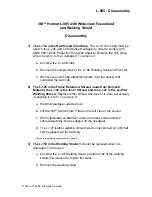
SAFETY INFORMATION
2-5
2
vide the best combination of handling,
braking, and comfort. Other tires, rims,
sizes, and combinations may not be
appropriate. Refer to page 7-21 for tire
specifications and more information on
replacing your tires.
EAU10372
Further safe-riding points
●
Be sure to signal clearly when
making turns.
●
Braking can be extremely difficult
on a wet road. Avoid hard brak-
ing, because the scooter could
slide. Apply the brakes slowly
when stopping on a wet surface.
●
Slow down as you approach a
corner or turn. Once you have
completed a turn, accelerate
slowly.
●
Be careful when passing parked
cars. A driver might not see you
and open a door in your path.
●
Railroad crossings, streetcar
rails, iron plates on road construc-
tion sites, and manhole covers
become extremely slippery when
wet. Slow down and cross them
with caution. Keep the scooter
upright, otherwise it could slide
out from under you.
●
The brake pads could get wet
when you wash the scooter. After
washing the scooter, check the
brakes before riding.
●
Always wear a helmet, gloves,
trousers (tapered around the cuff
and ankle so they do not flap),
and a bright colored jacket.
●
Do not carry too much luggage on
the scooter. An overloaded scoot-
er is unstable. Use a strong cord
to secure any luggage to the car-
rier (if equipped). A loose load will
affect the stability of the scooter
and could divert your attention
from the road. (See page 2-3.)
33SF8199E0.book Page 5 Friday, December 11, 2009 1:56 PM













































